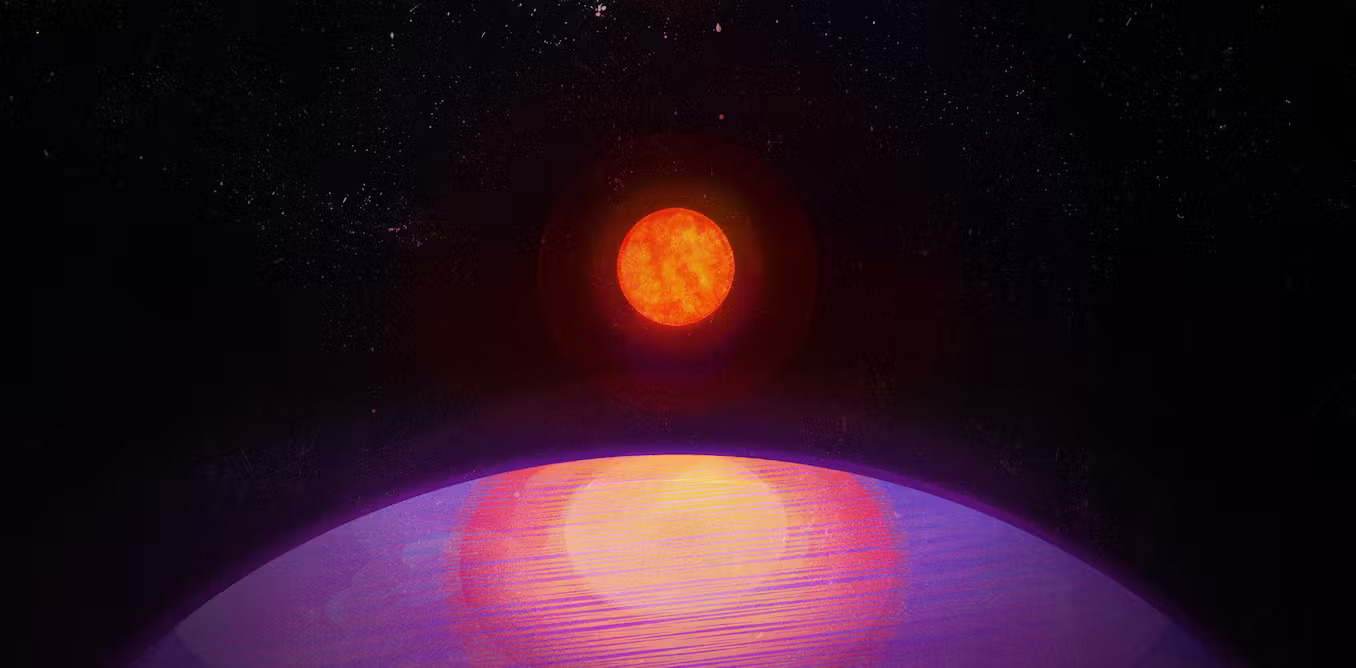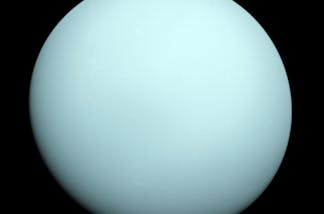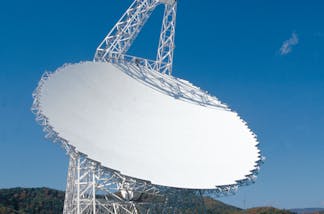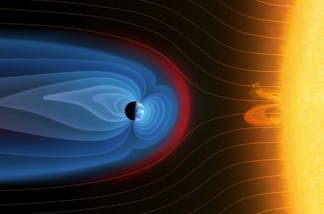 LHS 3154b, a newly discovered massive planet that should be too big to exist. The Pennsylvania State University
LHS 3154b, a newly discovered massive planet that should be too big to exist. The Pennsylvania State University
–
![]() By Verne M. Willaman Professor of Astronomy & Astrophysics, Penn State
By Verne M. Willaman Professor of Astronomy & Astrophysics, Penn State
and by
![]() NASA Hubble Fellow, Department of Astrophysical Sciences, Princeton University
NASA Hubble Fellow, Department of Astrophysical Sciences, Princeton University
and by
![]() Graduate Student, Department of Astronomy, Penn State
Graduate Student, Department of Astronomy, Penn State
–
Imagine you’re a farmer searching for eggs in the chicken coop – but instead of a chicken egg, you find an ostrich egg, much larger than anything a chicken could lay.
That’s a little how our team of astronomers felt when we discovered a massive planet, more than 13 times heavier than Earth, around a cool, dim red star, nine times less massive than Earth’s Sun, earlier this year.
The smaller star, called an M star, is not only smaller than the Sun in Earth’s solar system, but it’s 100 times less luminous. Such a star should not have the necessary amount of material in its planet-forming disk to birth such a massive planet.
The Habitable Zone Planet Finder
Over the past decade, our team designed and built a new instrument at Penn State capable of detecting the light from these dim, cool stars at wavelengths beyond the sensitivity of the human eye – in the near-infrared – where such cool stars emit most of their light.
Attached to the 10-meter Hobby-Eberly Telescope in West Texas, our instrument, dubbed the Habitable Zone Planet Finder, can measure the subtle change in a star’s velocity as a planet gravitationally tugs on it. This technique, called the Doppler radial velocity technique, is great for detecting exoplanets.
“Exoplanet” is a combination of the words extrasolar and planet, so the term applies to any planet-sized body in orbit around a star that isn’t Earth’s Sun.
Thirty years ago, Doppler radial velocity observations enabled the discovery of 51 Pegasi b, the first known exoplanet orbiting a Sun-like star. In the ensuing decades, astronomers like us have improved this technique. These increasingly more precise measurements have an important goal: to enable the discovery of rocky planets in habitable zones, the regions around stars where liquid water can be sustained on the planetary surface.
The Doppler technique doesn’t yet have the capabilities to discover habitable zone planets the mass of the Earth around stars the size of the Sun. But the cool and dim M stars show a larger Doppler signature for the same Earth-size planet. The lower mass of the star leads to it getting tugged more by the orbiting planet. And the lower luminosity leads to a closer-in habitable zone and a shorter orbit, which also makes the planet easier to detect.
Planets around these smaller stars were the planets our team designed the Habitable Zone Planet Finder to discover. Our new discovery, published in the journal Science, of a massive planet orbiting closely around the cool dim M star LHS 3154 – the ostrich egg in the chicken coop – came as a real surprise.
LHS 3154b: The planet that should not exist
Planets form in disks composed of gas and dust. These disks pull together dust grains that grow into pebbles and eventually combine to form a solid planetary core. Once the core is formed, the planet can gravitationally pull in the solid dust, as well as surrounding gas such as hydrogen and helium. But it needs a lot of mass and materials to do this successfully. This way to form planets is called core accretion.
A star as low mass as LHS 3154, nine times less massive than the Sun, should have a correspondingly low-mass planet forming disk.
–
A typical disk around such a low-mass star should simply not have enough solid materials or mass to be able to make a core heavy enough to create such a planet. From computer simulations our team conducted, we concluded that such a planet needs a disk at least 10 times more massive than typically assumed from direct observations of planet-forming disks.
A different planet formation theory, gravitational instability – where gas and dust in the disk undergo a direct collapse to form a planet – also struggles to explain the formation of such a planet without a very massive disk.
Planets around the most common stars
Cool, dim M stars are the most common stars in our galaxy. In DC comics lore, Superman’s home world, planet Krypton, orbited an M dwarf star.
Astronomers know, from discoveries made with Habitable Zone Planet Finder and other instruments, that giant planets in close-in orbits around the most massive M stars are at least 10 times rarer than those around Sun-like stars. And we know of no such massive planets in close orbits around the least massive M stars – until the discovery of LHS 3154b.
Understanding how planets form around our coolest neighbors will help us understand both how planets form in general and how rocky worlds around the most numerous types of stars form and evolve. This line of research could also help astronomers understand whether M stars are capable of supporting life.
–
–
Guðmundur Kári Stefánsson receives funding from NSF, NASA and the Heising-Simons Foundation.
Megan Delamer receives funding from NSF, NASA, and Heising-Simons Foundation.
Partners

Penn State provides funding as a founding partner of The Conversation US.View all partners
Republish our articles for free, online or in print, under a Creative Commons license.
–
Want to write?
Write an article and join a growing community of more than 174,700 academics and researchers from 4,809 institutions.













Suvrath Mahadevan
Verne M. Willaman Professor of Astronomy & Astrophysics, Penn State
A nice Perspective article on our discovery of this planet LHS 3154b can also be found in Science – at this link (though it might be behind the Science firewall and not easily accessible https://www.science.org/doi/epdf/10.1126/science.adl3365
–